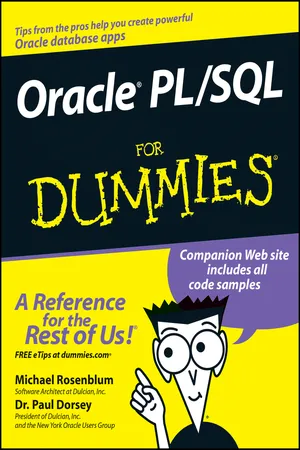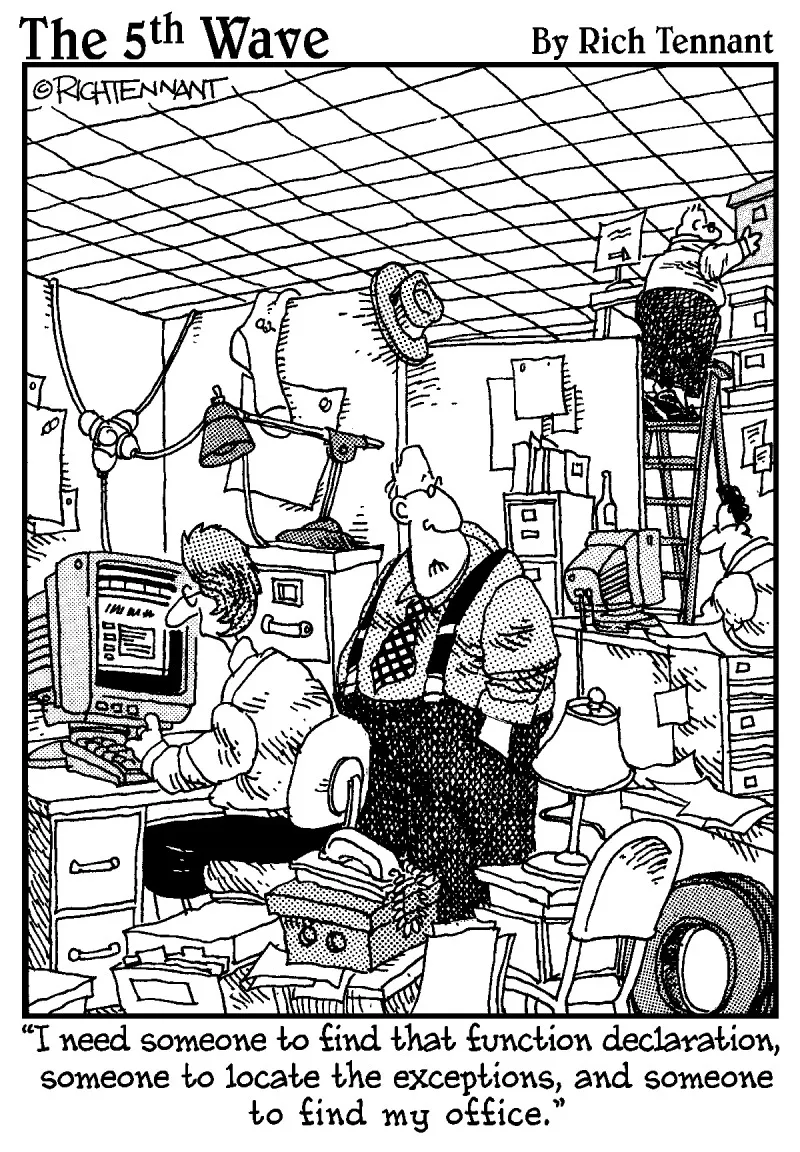
This is a test
- English
- ePUB (mobile friendly)
- Available on iOS & Android
eBook - ePub
Oracle PL / SQL For Dummies
Book details
Book preview
Table of contents
Citations
About This Book
Find tips for creating efficient PL/SQL code
If you know a bit about SQL, this book will make PL/SQL programming painless!
The Oracle has spoken—you need to get up to speed on PL/SQL programming, right? We predict it'll be a breeze with this book! You'll find out about code structures, best practices, and code naming standards, how to use conditions and loops, where to place PL/SQL code in system projects, ways to manipulate data, and more.
Discover how to
- Write efficient, easy-to-maintain code
- Test and debug PL/SQL routines
- Integrate SQL and PL/SQL
- Apply PL/SQL best practices
- Use new features introduced in Oracle 9i and 10g
Frequently asked questions
At the moment all of our mobile-responsive ePub books are available to download via the app. Most of our PDFs are also available to download and we're working on making the final remaining ones downloadable now. Learn more here.
Both plans give you full access to the library and all of Perlego’s features. The only differences are the price and subscription period: With the annual plan you’ll save around 30% compared to 12 months on the monthly plan.
We are an online textbook subscription service, where you can get access to an entire online library for less than the price of a single book per month. With over 1 million books across 1000+ topics, we’ve got you covered! Learn more here.
Look out for the read-aloud symbol on your next book to see if you can listen to it. The read-aloud tool reads text aloud for you, highlighting the text as it is being read. You can pause it, speed it up and slow it down. Learn more here.
Yes, you can access Oracle PL / SQL For Dummies by Michael Rosenblum, Paul Dorsey in PDF and/or ePUB format, as well as other popular books in Computer Science & Software Development. We have over one million books available in our catalogue for you to explore.
Information
Part I
Basic PL/SQL Concepts

In this part . . .
Part I includes two chapters to get you started with PL/SQL. Because you need to understand something about relational databases to be a good PL/SQL programmer, Chapter 1 provides a quick overview of the most important concepts. It also reviews some database terminology and explains some of the differences between SQL and PL/SQL. For those with very little programming experience, Chapter 1 includes a very brief explanation of the basic structure and syntax of PL/SQL and explains where it is most useful.
Chapter 2 describes the total PL/SQL environment and explains how to set up this environment so you can begin writing code. You discover how to set up a database, connect to it, and access the Oracle sample schemas that you can use to practice.
Chapter 1
PL/SQL and Your Database
In This Chapter





PL/SQL is an extension to the industry-standard SQL language. Oracle Corporation developed PL/SQL and released the first version in 1991. PL/SQL is an easy-to-use procedural language that interacts seamlessly with the Oracle database. Server-side PL/SQL is part of the Oracle database and needs no explicit installation or licensing.
This chapter introduces you to PL/SQL and provides some basics about relational databases.
Knowing Just Enough about Relational Databases
Building a system in Oracle or some other relational database product does not automatically make it a relational database. Similarly, you can design a perfectly good relational database and implement it in something other than a relational database product. We discuss two important areas:


What makes a database “relational”?
When a database is described as relational, it has been designed to conform (at least mostly) to a set of practices called the rules of normalization. A normalized database is one that follows the rules of normalization.
For example, in an organization, you have employees who work in specific departments. Each employee and department has a number and a name. You could organize this information as shown in Table 1-1.

If you structure your data this way and make certain changes to it, you’ll have problems. For example, deleting all the employees in the Purchasing department will eliminate the department itself. If you change the name of the Marketing department to “Advertising,” you would need to change the record of each employee in that department.
Using the principles of relational databases, the Employee and Department data can be restructured into two separate tables (DEPT and EMP), as shown in Tables 1-2 and 1-3.
| DeptNo | DeptName | |
|---|---|---|
| 10 | Marketing | |
| 20 | Purchasing |
| EmpNo | EName | DeptNo |
|---|---|---|
| 101 | Abigail | 10 |
| 102 | Bob | 20 |
| 103 | Carolyn | 10 |
| 104 | Doug | 20 |
| 105 | Evelyn | 10 |
By using this structure, you can examine the EMP table to find out that Doug works in department 20. Then you can check the DEPT table to find out that department 20 is Purchasing. You might think that Table 1-1 looks more efficient. However, retrieving the information you need in a number of different ways is much easier with the two-table structure. Joining the information in the two tables for more efficient retrieval is exactly the problem that relational databases were designed to solve.
When the tables are implemented in the database, the information in the two tables is linked by using special columns called foreign keys. In the example, the DeptNo column is the foreign key linking the Department and Employee tables.
Tables 1-4 and 1-5 show another common database structure, namely a purchase order (PURCH_ORDER table) for an item and the information details associated with the purchase order (PURCH_ORDER_DTL table).
| PO_Nbr | Date | |
|---|---|---|
| 450 | 12/10/2006 | |
| 451 | 2/26/2006 | |
| 452 | 3/17/2006 | |
| 453 | 6/5/2006 |

A purchase order can include many items. Table 1-5 shows that Purchase Order 451 includes three separate items. The link (forei...
Table of contents
- Title
- Contents
- Introduction
- Part I : Basic PL/SQL Concepts
- Part II : Getting Started with PL/SQL
- Part III : Standards and Structures
- Part IV : PL/SQL Data Manipulations
- Part V : Taking PL/SQL to the Next Level
- Part VI : The Part of Tens